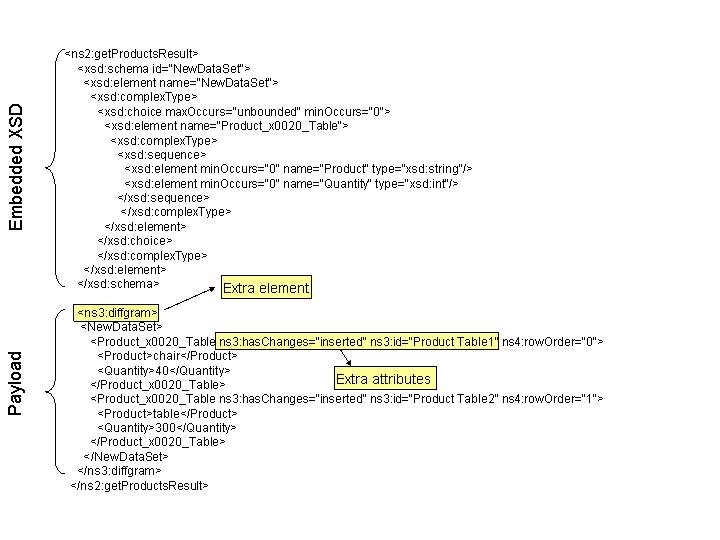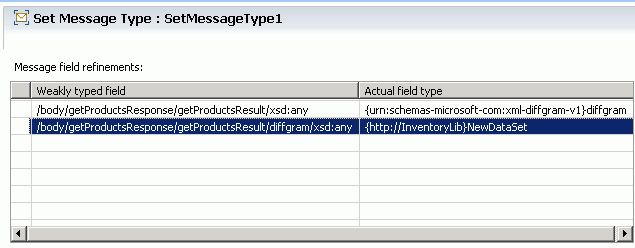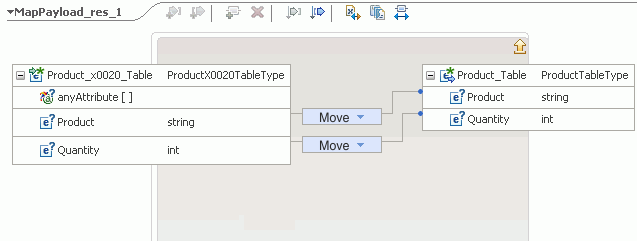IBM BPM, V8.0.1, All platforms > Authoring services in Integration Designer > Services and service-related functions > Building mediation flows
Work with Microsoft ADO.NET services
ADO.Net clients and servers use diffgrams in their schemas to transfer and update data. Diffgrams are not compatible with the W3C XML 1.0 schema that IBM Integration Designer requires. Learn how to use mediation flows to create, manipulate and consume .NET messages that contain diffgrams, with no changes required to the original service WSDL.
Understanding ADO.NET schema
Diffgrams are XML constructs that contain information on the current and original state of data that has changed. When there is a change in the state of data, diffgrams are inserted into the schema. The information in the diffgram is used to update data on the client's web user interface, or to persist data on the server. Here is an example of a response from an ADO.NET service that contains diffgrams:

Figure 1. Example response from ADO.NET
As the previous schema shows, the payload does not match the embedded schema definition. There is an extra diffgram element, and there are also extra attributes that are not defined in the schema.
In order to handle this payload, it needs to be represented in a format that IBM Integration Designer can handle. This is achieved by generating helper schemas that convert the diffgram and extra attributes into xsd files. The next step is to get the payload information, which you can get by calling the service, or from the service provider as an xsd file. Once you have the xsd files, you can use the capability to work with xsd:any to read and write the data inside a diffgram.
Generate helper schema
Follow these steps to generate the helper schema:
- Import the original WSDL file from the Microsoft ADO.NET project into a mediation module or library.
- Add the line <s:element ref="s:schema" /> to the WSDL message element so that IBM Integration Designer can correctly handle the response from the ADO.NET service. For the example response shown in figure 1, the WSDL should be modified as follows:
<?xml version="1.0" encoding="utf-8"?> <wsdl:definitions xmlns:soap="http://schemas.xmlsoap.org/wsdl/soap/ xmlns:tm="http://microsoft.com/wsdl/mime/textMatching/" ... ... ... xmlns:wsdl="http://schemas.xmlsoap.org/wsdl/"> <wsdl:types> <s:schema elementFormDefault="qualified" targetNamespace="http://ibm.com/WID/DataSetTests/"> 1 <s:import namespace="http://www.w3.org/2001/XMLSchema" /> <s:element name="getProducts"> <s:complexType /> </s:element> <s:element name="getProductsResponse"> <s:complexType> <s:sequence> <s:element minOccurs="0" maxOccurs="1" name="getProductsResult"> <s:complexType> <s:sequence> 2 <s:element ref="s:schema" /> <s:any /> </s:sequence> </s:complexType> </s:element> </s:sequence> </s:complexType> </s:element> ... (more elements) </wsdl:types> </wsdl:definitions>- 1 Add import
- 2 Add <s:element ref="s:schema" />
- Generate the helper schema, in one of the following ways:
- Go to the Problems view, and locate the error message for the WSDL file. Right click the error message, and click Quick Fix to generate the helper schema.
-
Generate the helper schema from the Dependencies editor:
- Expand the module or library where the WSDL file is located, and click the dependency editor icon

- In the dependency editor, expand Predefined Resources and select Microsoft ADO .NET DataSet schema file. Save the changes.
Two helper schemas are created in your mediation module or library. You can view them in the Physical Resources view:

The files created are diffgram.xsd, which is the helper schema for diffgrams, and msdata.xsd, which defines global attributes.
- Expand the module or library where the WSDL file is located, and click the dependency editor icon
If you simply want to pass through to the .Net service without accessing the payload data, for example if you simply want to log the response from the service, you can now proceed to create your mediation flow. If you want to access and manipulate the payload data, see topics "Get the payload schema" and "Access the payload schema" below.
Get the payload schema
If you want to access the business data or payload in the response from the .NET service, you need to obtain the payload schema in one of the following ways:
- Your client or service provider may have given you the payload schema as an xsd file. In this case, import the file that into your library or mediation module.
- If you don't have the payload schema file, you can obtain it by using the test client to save the results from the service invocation
as an xsd file, as follows:
- Create a Web Service Import to call the web service using the test client.
- In the test client, invoke the required operation

- When you get the response from the operation, display the results in the SDO view by clicking the icon Display the SDO style
view

in the Response Parameters table.
- In the SDO style view, right click, and choose Export to XML file.
- Save the payload to an xsd file (for example, payload.xsd).
Modify the payload schema
If you want to create diffgrams that perform insert, update and delete operations to a database on the .NET server, you need to modify the payload schema.
To modify the schema, edit the payload xsd file to include the <xsd:anyAttribute> in each complexType element that corresponds to a database table on the server, as shown below:
<?xml version="1.0" encoding="UTF-8"?> <xsd:schema id="NewDataSet" xmlns:xsd="http://www.w3.org/2001/XMLSchema" targetNamespace="http://InventoryLib"> <xsd:element name="NewDataSet"> <xsd:complexType> <xsd:choice maxOccurs="unbounded" minOccurs="0"> <xsd:element name="Product_x0020_Table"> <xsd:complexType> <xsd:sequence> <xsd:element minOccurs="0" name="Product" type="xsd:string" /> <xsd:element minOccurs="0" name="Quantity" type="xsd:int" /> </xsd:sequence> <xsd:anyAttribute namespace="##any" processContents="lax" /> </xsd:complexType> </xsd:element> </xsd:choice> </xsd:complexType> </xsd:element> </xsd:schema>
Access the payload schema in a mediation flow
To access and manipulate the payload in a mediation flow, first generate the helper schema and obtain the payload schema. Then, in the mediation flow, drop a Set Message Type primitive to assert the actual type for the diffgram and the payload content. Now, you have full access to the structure of the diffgram message, for mapping or XPath access.
These are some use cases you can build in the mediation flow:
- Cast dynamic data content using the Set Message Type primitive.
- Read and write data in the diffgram block using the Message Element Setter, when used in conjunction with the Set Message Type primitive.
- Provide mapping for the diffgram payload in the Mapping primitive or the Business Object Map primitive, when used in conjunction with the Set Message Type primitive.
The examples in the following sections illustrate these scenarios.
Example: Log the message and pass through
In this example, you want to consume a response from a .NET service, and log the response. You do not need to access the response payload. The requester's interface is the same as that of the service provider, and so a transform is not required. Proceed as follows:
- Import the original wsdl file from the Microsoft ADO.NET project into a mediation module or library.
- Generate helper schema.
- Implement the mediation flow component.
- Connect the source and target operations
- In the request flow, wire the input node to the callout node

- In the response flow, wire a message logger primitive between the callout and input response nodes. In the logger's properties view, set the root property to specify the part of the message that you want to log.

Example: Update diffgram content using XPath
In this example, you want to update an element in a diffgram block in the response message from a .NET service. In this situation, you don't have the payload schema, but you know the structure of the data. You can access the element by manually entering the XPath to the diffgram content, assuming that you know this location path.
- Import the original wsdl file from the Microsoft ADO.NET project into a mediation module or library.
- Generate helper schema.
- Implement the mediation flow component.
- Connect the source and target operations
- In the request flow, wire the input node to the callout node

- In the response flow, wire a Message Element Setter primitive
between the callout and input response nodes.

- In the properties view of Message Element Setter, add a message element. In the target field, specify the XPath expression for the location of the element that you want to update, and enter a type and value.

Example: Update diffgram content using payload schema
In this example, you want to update an element in a diffgram block in the response message from a .NET service. In this situation, you have the payload schema, so you can use Set Message Type together with Message Element Setter to update the element.
- Import the original wsdl file from the Microsoft ADO.NET project into a mediation module or library.
- Generate helper schema.
- Get the payload schema
- Implement the mediation flow component.
- Connect the source and target operations
- In the request flow, wire the input node to the callout node

- In the response flow, wire a Set Message Type primitive and a Message Element Setter primitive between the callout and input response nodes. We will use the Set Message Type primitive to cast the diffgram
any type to the business object that we need. We can then use Message Element Setter to update the required element.

- In the properties view of SetMessageType1 set the following:
- First, set the <xsd:any> to the diffgram business object.
- Then, set the <xsd:any> in the diffgram to the actual payload business object

If you hover over the input and output terminals of the Set Message Type primitive, you will see the change in input and output message types. The input message type shown below does not show the message body.

The output message type shown below has the business object that contains the element that we want to access.

- In the properties view of Message Element Setter, click Add, and then Edit to launch the XPath Expression Builder. You can now drill
down the message to choose the target message element that you want to update.

Example: Transform a response from a .Net service
In this example, you want to consume a response from a .NET service, and transform the response to the format expected by the service provider. Proceed as follows:
- Import the original wsdl file from the Microsoft ADO.NET project into a mediation module or library.
- Generate helper schema.
- Get the payload schema
- In the assembly editor, create the following:
- An export, with web service binding. When you import the service requester's wsdl file, an interface is created for each port type defined in the wsdl file. Give the export the appropriate interface
- A mediation flow component
- An import, with the interface of the service provider. Use a web service binding, with the address from the original wsdl file.
- Wire together the export, mediation flow component, and the import.

- Implement the mediation flow component.
- Connect the source and target operations
- In the request flow, wire the Mapping primitive between the input
and callout.

- The response from the service is in the anyType format. In order
to transform the message, you need to convert the anyType field into the elements you want. In the response flow, wire a Set Message Type primitive and a Mapping primitive between the callout and input response nodes. We will use the Set Message Type primitive to cast the diffgram
any type to the business object that we need. We can then use XSLT
Transformation primitive to perform the required mapping.
You can use the Business Object Map instead of the Mapping primitive.

- In the properties view of SetDiffgramAndPayloadType set the following properties in the message field refinements table.
- First, set the <xsd:any> to the diffgram business object:
- Weakly typed field
- /body/getProductsResponse/getProductsResult/xsd:any
- Actual field type
- {urn: schemas-microsoft-com:xml-diffgram-v1}diffgram
- Then, set the <xsd:any> in the diffgram to the actual payload
business object:
- Weakly typed field
- /body/getProductsResponse/getProductsResult/diffgram/xsd:any
- Actual field type
- {null}NewDataSet
If you hover over the input and output terminals of the Set Message Type primitive, you will see the change in input and output message types. The input message type shown below does not show the message body.

The output message type shown below has the business object that contains the element that we want to access.

- First, set the <xsd:any> to the diffgram business object:
- In the properties view of MapPayload, create the mapping file.
First, map the NewDataSet to the corresponding element in the target, using an inline map transform.

- Next, map the elements within the inline map, using the move transform.

Example: Create a diffgram message
In this example, you want to create a diffgram message.
For example, you may want to persist the data on a .NET server. Proceed as follows:
- Import the original wsdl file from the Microsoft ADO.NET project into a mediation module or library.
- Generate helper schema
- Get the payload schema
- Modify the payload schema.
- Implement the mediation flow component.
- Connect the source and target operations
- In the request flow, wire a Custom Mediation primitive between the input and callout nodes to create the diffgram.

- Implement Java™ code as either
a Java snippet or a Visual snippet
in the custom mediation to create a diffgram and set payload information and attributes:
-
Java snippet implementationIn the Java Imports page in the properties view, add these import statements:
import commonj.sdo.DataObject; import com.ibm.websphere.sibx.smobo.ServiceMessageObjectFactory; import com.ibm.websphere.bo.BOFactory; import com.ibm.websphere.sca.ServiceManager; import com.ibm.websphere.bo.BOXSDHelper; import commonj.sdo.Property; import com.ibm.websphere.bo.BOXMLSerializer; import java.io.InputStream; import java.math.BigInteger;
- In the Details properties page, add your Java code. See the example code
below; details are provided in the comments in the code.
/** * GENERATED COMMENT - DO NOT MODIFY * Variables: for output terminals - out (com.ibm.wsspi.sibx.mediation.OutputTerminal) * for user properties - <No user properties defined> * Inputs: inputTerminal (com.ibm.wsspi.sibx.mediation.InputTerminal), smo (com.ibm.websphere.sibx.smobo.ServiceMessageObject) * Exceptions: com.ibm.wsspi.sibx.mediation.MediationConfigurationException, com.ibm.wsspi.sibx.mediation.MediationBusinessException */ // Step 1a: Create an SMO body DataObject newBody = (DataObject) ServiceMessageObjectFactory.eINSTANCE.createServiceMessageObject(new javax.xml.namespace.QName("http://ibm.com/WID/DataSetTests/", "addProductsSoapIn")).getBody(); // Step 1b: Create wrappers addProducts and products DataObject addProductsElement = newBody.createDataObject("addProducts"); DataObject productsElement = addProductsElement.createDataObject("products"); // Step 1c: Set the SMO body smo.set("body", newBody); // Step 2a: Create a BO from payload schema NewDataSet.xsd DataObject schemaBO = null; try { BOXMLSerializer boXMLSerializer = (BOXMLSerializer) ServiceManager.INSTANCE.locateService("com/ibm/websphere/bo/BOXMLSerializer"); InputStream inputStream = this.getClass().getClassLoader().getResourceAsStream("NewDataSet.xsd"); schemaBO = (DataObject) boXMLSerializer.readXMLDocument(inputStream).getDataObject();} catch(java.io.FileNotFoundException ex){} catch(java.io.IOException ex2){} // Step 2b: Add schema BO to SMO body wrapper DataObject dummy = productsElement.createDataObject("schema"); productsElement.setDataObject("schema", schemaBO); // Step 3a: Create diffgram BOFactory boFactory = (BOFactory) ServiceManager.INSTANCE.locateService("com/ibm/websphere/bo/BOFactory"); DataObject diffgram = boFactory.createByElement("urn:schemas-microsoft-com:xml-diffgram-v1","diffgram"); // Step 3b: Add diffgram to SMO body wrapper BOXSDHelper boXSDHelper = (BOXSDHelper) ServiceManager.INSTANCE.locateService("com/ibm/websphere/bo/BOXSDHelper"); // Get global property for diffgram Property diffgramProperty = boXSDHelper.getGlobalProperty("urn:schemas-microsoft-com:xml-diffgram-v1", "diffgram", true); // Set wildcard xsd:any with global element diffgram productsElement.getSequence().add(diffgramProperty, diffgram); // Step 4a: Create payload DataObject payload = boFactory.createByElement(null,"NewDataSet"); // Step 4b: Set payload DataObject Product_x0020_TableBO = payload.createDataObject("Product_x0020_Table"); Product_x0020_TableBO.set("Product", "chair"); Product_x0020_TableBO.set("Quantity", "40"); // Step 4c: Add payload to diffgram Property payloadProperty = boXSDHelper.getGlobalProperty(null, "NewDataSet", true); diffgram.getSequence().add(payloadProperty, payload); // Step 5: Set diffgram attributes "rowOrder" and "hasChanges" Property rowOrderProperty = boXSDHelper.getGlobalProperty("urn:schemas-microsoft-com:xml-msdata", "rowOrder", false); Product_x0020_TableBO.set(rowOrderProperty, new BigInteger("0")); Property hasChangesProperty = boXSDHelper.getGlobalProperty("urn:schemas-microsoft-com:xml-diffgram-v1", "hasChanges", false); Product_x0020_TableBO.set(hasChangesProperty, "inserted"); // propagate the service message object to the primitive that is wired to the 'out' terminal out.fire(smo);
-
Visual snippet implementationIn the Details properties page, add a visual snippet, as shown below:

-